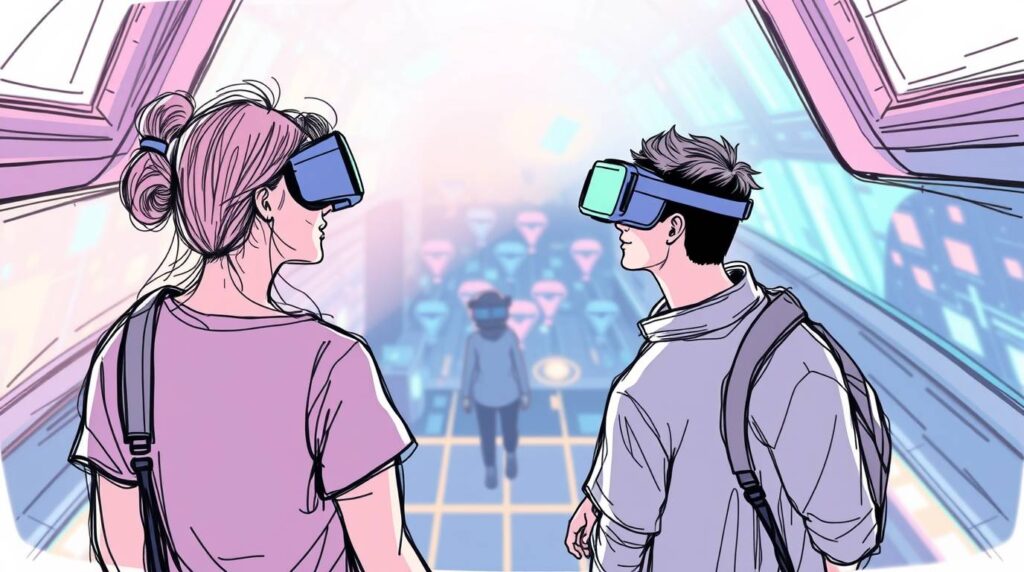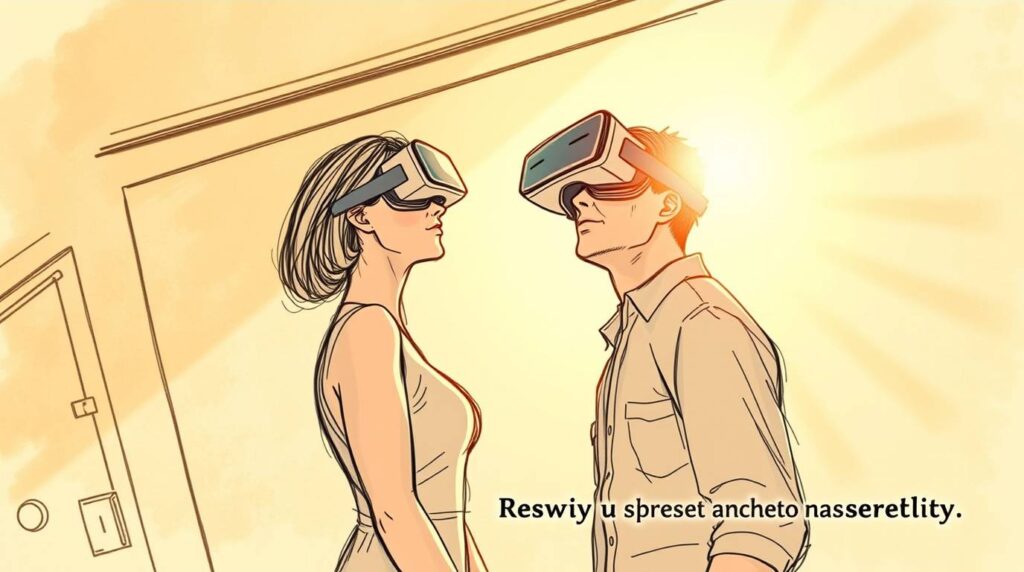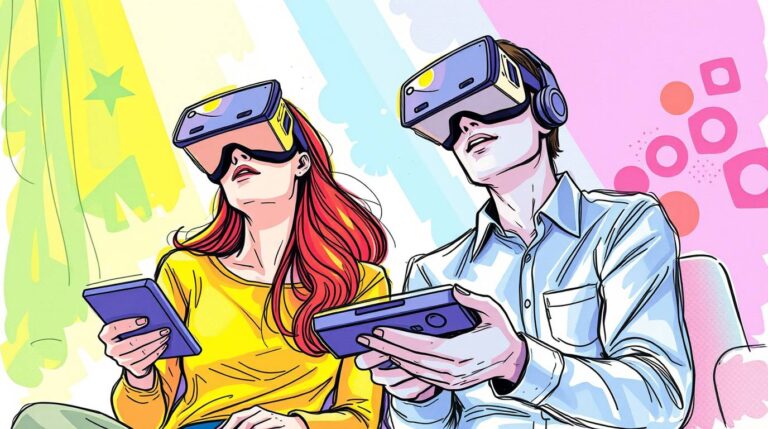Virtual Reality (VR) gaming stands as a frontier in interactive entertainment, offering unprecedented levels of immersion that bridge the gap between players and digital worlds. From its speculative origins to its current state of burgeoning growth and immense future potential, VR gaming is continually redefining what it means to play.
History of Virtual Reality Games: From Sci-Fi Dream to Nascent Reality
The concept of virtual reality dates back far beyond modern computing. Early attempts at immersive experiences include Morton Heilig’s Sensorama in the 1960s, a multi-sensory simulator that offered stereoscopic 3D, stereo sound, vibrations, and even smells. However, the true genesis of VR as we understand it, particularly in relation to gaming, began to take shape in the late 20th century.
In the 1980s, figures like Jaron Lanier, co-founder of VPL Research, coined the term “virtual reality” and developed early hardware like the DataGlove, an input device that allowed users to interact with virtual environments. While these were groundbreaking, they were largely experimental and prohibitively expensive, limiting their application.
The 1990s saw the first notable, albeit limited, forays into consumer VR gaming. Nintendo’s Virtual Boy, released in 1995, was a commercial failure due to its monochromatic display, uncomfortable design, and lack of compelling software. Sega also experimented with the Sega VR, but it never made it past the prototype stage for home consoles, though some of its head-tracking technology found its way into arcade cabinets like the VR-1. Arcade VR systems like Virtuality offered glimpse into the potential, but the technology was still too nascent and costly for widespread adoption.
The true turning point arrived in the 2010s. Palmer Luckey’s Oculus Rift, unveiled via a Kickstarter campaign in 2012, ignited a new wave of excitement and investment in VR. Its promise of high-quality, immersive gaming experiences at a more accessible price point captivated developers and enthusiasts alike. This resurgence led to major tech companies entering the fray, with HTC releasing the Vive and Sony introducing the PlayStation VR. These headsets, coupled with advancements in computing power and graphics, finally brought consumer-ready VR gaming to a broader audience, albeit still a niche one.
Since then, the evolution has been rapid. Untethered headsets like the Oculus (now Meta) Quest line have made VR more accessible and convenient, while PC-based VR continues to push the boundaries of visual fidelity and interactive complexity.
Current State of VR Gaming: A Period of Transition and Specialization
The VR gaming market in mid-2025 finds itself in an interesting phase. After a period of significant hype and investment, particularly around 2020-2022, there’s been a noticeable slowdown in consumer VR hardware sales and content adoption. Reports indicate a decline in VR headset sales in 2023, and many developers perceive the VR gaming market as stagnating or even declining.
Several factors contribute to this:
- Economic Pressures: Inflationary pressures on consumer spending have impacted discretionary purchases like VR headsets.
- Lack of “Killer App”: While there are critically acclaimed VR titles, a truly mass-market “killer app” capable of attracting a mainstream audience comparable to traditional gaming hits has yet to emerge.
- Cost and Convenience: VR headsets, especially higher-end PC-tethered ones, can still be expensive. Even standalone headsets, while more affordable, require a significant investment for many. The need to wear a device on one’s head for extended periods also presents a comfort barrier.
- Niche Market: The VR gaming audience remains relatively small compared to traditional gaming, making profitability challenging for many developers.
However, it’s not all doom and gloom. The VR market is segmenting, with significant growth seen in non-entertainment sectors. VR for education, training, and B2B applications is flourishing, proving highly effective and cost-efficient for various industries. This suggests that while consumer VR gaming faces headwinds, the underlying technology continues to mature and find valuable applications.
The launch of devices like the Apple Vision Pro in early 2024, while primarily focused on mixed reality and productivity, has certainly brought renewed attention to immersive technologies and may indirectly benefit the broader VR ecosystem by driving innovation and user awareness.
Despite the current challenges, the core appeal of VR gaming – unparalleled immersion – continues to drive development and innovation. Companies are actively working on making headsets more comfortable, powerful, and affordable, while developers continue to explore new gameplay mechanics unique to the VR medium.

Popular Genres in Virtual Reality Games
VR’s immersive nature lends itself particularly well to certain genres, transforming familiar gameplay into breathtaking new experiences. Some of the most popular and impactful VR gaming genres include:
- First-Person Shooters (FPS): The genre that perhaps most benefits from VR’s immersion. Titles like Half-Life: Alyx have set a new bar for what is possible in VR FPS, offering incredibly tactile weapon handling, environmental interaction, and a sense of “being there” that traditional FPS games can’t replicate. The ability to physically aim, duck, and reload adds a layer of depth and excitement.
- Rhythm Games: Games like Beat Saber have become breakout hits in VR. The intuitive nature of slicing blocks to the rhythm of music, combined with the physical movement, creates an incredibly satisfying and addictive experience. These games are often cited as excellent entry points for new VR users due to their immediate appeal and lower incidence of motion sickness.
- Action-Adventure: VR elevates adventure games by placing players directly into sprawling worlds. Titles like The Elder Scrolls V: Skyrim VR or Horizon Call of the Mountain allow players to explore vast landscapes, engage in visceral combat, and solve puzzles with a profound sense of presence.
- Simulation Games: From intricate flight simulators to realistic job simulations (Job Simulator), VR allows for a highly accurate and engaging replication of real-world activities. The ability to physically manipulate controls and objects enhances the feeling of performing the task.
- Horror Games: VR intensifies horror by placing players directly within the terrifying environments. The sense of isolation, claustrophobia, and vulnerability is amplified when jump scares and unsettling atmospheres surround you completely. Resident Evil 7: Biohazard in VR is often cited as a truly terrifying experience.
- Puzzle Games: VR introduces new dimensions to puzzle-solving. Manipulating objects in 3D space, interacting with environment elements, and using your physical body to solve riddles can be incredibly engaging.
- Social VR Experiences: While not strictly a genre, social VR platforms allow players to interact with others in virtual spaces, attend events, or simply hang out. These platforms are crucial for fostering a sense of community and expanding the social aspect of VR beyond competitive gaming.
Technological Requirements for VR Gaming
To deliver a truly immersive and comfortable VR experience, a combination of advanced hardware and software is essential. The requirements vary depending on the type of VR headset:
1. PC-Tethered VR (e.g., Valve Index, Older Oculus Rift/Vive):
- High-Performance PC: These headsets offload the processing power to a powerful desktop computer.
- Graphics Card (GPU): This is the most crucial component. A high-end GPU like an NVIDIA GeForce RTX 3070 (or equivalent AMD Radeon) is generally recommended for a smooth experience at high resolutions and frame rates. For the best experience, an RTX 3080 or higher is preferred. VR rendering requires two slightly different images for each eye at a high refresh rate (often 90Hz or 120Hz) to prevent motion sickness, demanding immense graphical horsepower.
- Processor (CPU): A modern Intel Core i7 (11th Gen or newer) or AMD Ryzen 5/7 (5000 series or newer) is typically recommended to avoid bottlenecks.
- RAM: 16GB is a good baseline, with 32GB or more recommended for demanding titles.
- Storage: SSD (Solid State Drive) is highly recommended for faster loading times.
- Video Output: Compatible DisplayPort or HDMI ports, depending on the headset.
- USB Ports: Multiple USB 3.0 ports are often required for tracking sensors and headset connectivity.
- Tracking System:
- Outside-in tracking (e.g., Valve Index with Base Stations): External sensors placed in the play area track the headset and controllers with high precision. This offers excellent tracking accuracy but requires a dedicated setup space.
- Inside-out tracking (e.g., newer PC VR headsets, also common in standalone): Cameras on the headset itself track the surrounding environment and the controllers. This simplifies setup and offers more freedom of movement without external sensors.
2. Standalone VR (e.g., Meta Quest 2/3, Pico 4):
- Integrated Hardware: These headsets have all the necessary processing power, display, and tracking built directly into the device.
- Mobile Processors: They utilize powerful mobile chipsets (e.g., Qualcomm Snapdragon XR2) optimized for VR. While not as powerful as high-end PC GPUs, these are continually improving.
- Inside-out Tracking: This is the standard for standalone headsets, offering convenient setup and room-scale tracking without external equipment.
- Wireless Connectivity: Essential for untethered movement.
- Battery Life: A key consideration, as extended play sessions can drain the battery.
3. Console VR (e.g., PlayStation VR2):
- Dedicated Console: Requires a specific gaming console (e.g., PlayStation 5 for PS VR2).
- Headset and Controllers: Designed to integrate seamlessly with the console’s ecosystem.
- Optimized Performance: Games are specifically optimized for the console’s hardware, ensuring a consistent experience.

Common Technological Elements Across All VR Systems:
- High-Resolution Displays: Sharp visuals are crucial for immersion and reducing the “screen door effect” (seeing individual pixels).
- High Refresh Rates: 90Hz or higher is generally considered essential to prevent motion sickness and provide a smooth experience.
- Low Latency: The delay between head movement and image update must be minimal to avoid disorientation.
- Motion Controllers: Ergonomic controllers that accurately track hand and finger movements are vital for interacting with virtual objects.
- Haptic Feedback: Vibrations and other tactile sensations in controllers enhance realism and immersion.
- Audio: Immersive 3D audio is paramount for positional awareness and deepening the sense of presence.
Benefits of Playing Virtual Reality Games
Beyond entertainment, VR gaming offers a range of surprising benefits:
- Unparalleled Immersion: This is VR’s defining characteristic. Players don’t just look at a screen; they are inside the game world, fostering a deeper connection and sense of presence that traditional gaming cannot match. This leads to more memorable and impactful experiences.
- Enhanced Spatial Awareness and Motor Skills: VR games often require physical movement, precise hand-eye coordination, and spatial reasoning. This can improve real-world dexterity, balance, and understanding of 3D space. Many VR fitness applications leverage this for engaging workouts.
- Cognitive Benefits: VR can challenge problem-solving skills, memory, and cognitive flexibility. Navigating complex virtual environments and reacting to dynamic situations stimulates the brain in unique ways.
- Physical Activity and Fitness: Many VR games, especially rhythm and active titles, encourage physical movement, turning gaming into a fun way to exercise. This has led to the rise of “VR fitness” as a legitimate workout option.
- Social Interaction: Multiplayer VR games and social platforms allow players to connect with friends and strangers in shared virtual spaces, fostering a sense of community and collaboration. This can be particularly beneficial for individuals who may have limited social opportunities in the real world.
- Pain Management and Therapy: VR is increasingly used in medical settings to distract patients from pain during procedures or to provide exposure therapy for phobias and PTSD in a controlled environment. The immersive nature allows patients to confront fears or manage discomfort in a safe and gradual manner.
- Training and Education: While more prominent in enterprise VR, the benefits of immersive simulation for training translate to gaming. Players can learn new skills or experience scenarios that would be dangerous or impractical in real life.
- Stress Relief and Escapism: Like traditional gaming, VR provides a powerful form of escapism, allowing players to momentarily forget real-world stresses and immerse themselves in fantastical worlds.
Challenges in Virtual Reality Gaming
Despite its immense potential, VR gaming faces several significant hurdles that impact its widespread adoption:
- Cost of Entry: High-end VR systems still require a substantial financial investment, encompassing both the headset and, for PC VR, a powerful gaming computer. While standalone headsets have lowered this barrier, they are still a significant purchase for many.
- Hardware Limitations and Design:
- Weight and Comfort: Most VR headsets are still relatively bulky and heavy, leading to discomfort, pressure marks, and neck strain during extended play sessions.
- Motion Sickness (VR Sickness): A significant challenge. This occurs when there’s a discrepancy between what the eyes see (movement in VR) and what the inner ear senses (lack of physical movement). Symptoms can range from nausea and dizziness to headaches. While developers employ techniques to mitigate this (e.g., teleportation locomotion, vignetting), it remains a barrier for some users.
- Limited Field of View (FOV): While improving, the FOV in VR headsets is still narrower than natural human vision, sometimes creating a “binocular” effect.
- Resolution and “Screen Door Effect”: Despite advancements, the individual pixels can sometimes be visible, especially with lower-resolution headsets, breaking immersion.
- Cables (for PC VR): Tethered headsets restrict movement and can be a tripping hazard, though wireless adapters are available.
- Content Library and “Killer Apps”: While the number of VR games is growing, the library is still relatively smaller than traditional gaming. There’s a perceived lack of a truly groundbreaking, universally appealing “killer app” that would drive mass adoption, similar to how Wii Sports propelled the Nintendo Wii.
- Setup and Play Space: PC-tethered VR often requires a dedicated play space for room-scale experiences, which not all users have readily available. Even standalone VR benefits from an open area to avoid collisions.
- Battery Life (for Standalone VR): Extended gaming sessions on standalone headsets are often limited by battery life, requiring frequent recharging.
- Learning Curve for New Users: Interacting in VR, especially with controllers and locomotion schemes, can have a slight learning curve for those new to the technology.
- Social Isolation Concerns: While social VR exists, some worry that excessive time in VR could lead to social isolation from the real world, although this is a broader concern for all forms of immersive digital entertainment.
- Eyestrain and Eye Health: Prolonged VR use can lead to eye strain, similar to prolonged screen time. The long-term effects on eye health are still being studied.
- Privacy and Security: As VR becomes more integrated and collects more user data (e.g., eye tracking, movement patterns), concerns about data privacy and security are growing.
Future Prospects of VR Games
Despite the current challenges, the future of VR gaming appears incredibly promising, driven by continuous innovation and expanding applications:
- Hardware Advancements:
- Lighter, More Comfortable Headsets: Continued development of compact and ergonomic designs, potentially leveraging new materials and form factors (e.g., VR glasses).
- Higher Resolution and Wider FOV: Displays will become sharper, with wider fields of view, further eliminating the “screen door effect” and enhancing realism.
- Improved Wireless Performance: More robust and lower-latency wireless connectivity will become standard, making untethered VR the norm.
- Advanced Eye-Tracking and Foveated Rendering: Eye-tracking will allow headsets to only render the area the user is directly looking at in full detail, significantly reducing processing power requirements and allowing for more complex graphics.
- Enhanced Haptic Feedback: Full-body haptic suits and more sophisticated haptic feedback in controllers will make virtual interactions feel even more realistic.
- Mixed Reality (MR) Integration: The line between VR and AR will blur, allowing for seamless transitions between fully immersive virtual worlds and digital overlays on the real world. Devices like the Apple Vision Pro are leading this trend.
- Artificial Intelligence (AI) Integration:
- Smarter NPCs: AI will create more dynamic, believable, and reactive non-playable characters, leading to more engaging narratives and interactions.
- Procedural Content Generation: AI could be used to generate vast and diverse virtual worlds, reducing development time and offering endless exploration.
- Personalized Experiences: AI could adapt game environments and challenges based on player behavior and preferences.
- Cloud VR Gaming: 5G and future wireless technologies will enable cloud-based VR gaming, where powerful games are streamed directly to headsets, eliminating the need for high-end local hardware and making VR more accessible.
- Social VR and the Metaverse: The concept of the metaverse, interconnected virtual worlds where users can socialize, play, work, and create, will continue to evolve, with VR playing a central role. Social VR platforms will become more sophisticated, offering rich avatars, expressive communication, and shared experiences.
- VR Esports: As VR technology matures and becomes more precise, competitive VR gaming will grow, with dedicated esports leagues and professional players emerging.
- Innovative Gameplay Mechanics: Developers will continue to discover and refine gameplay mechanics unique to VR, moving beyond adaptations of traditional genres to truly native VR experiences.
- Cross-Platform Integration: Greater interoperability between different VR platforms and traditional gaming platforms will allow for larger player bases and more connected experiences.
- Accessibility and Affordability: The long-term trend will be towards more affordable headsets and content, making VR gaming accessible to a much broader audience.
- Health and Wellness Applications: Further integration of VR with fitness, mental health therapy, and rehabilitation will become more common, broadening VR’s impact beyond pure entertainment.
Virtual reality gaming has come a long way from its early, often clunky, iterations. While it currently faces challenges related to cost, comfort, and content library, the fundamental allure of unparalleled immersion remains. With continuous technological advancements, the integration of AI, and the promise of a more connected virtual future, VR gaming is poised to evolve into an even more transformative and pervasive form of entertainment, reshaping how we play, interact, and experience digital worlds. The journey has been fascinating, and the best is undoubtedly yet to come.
